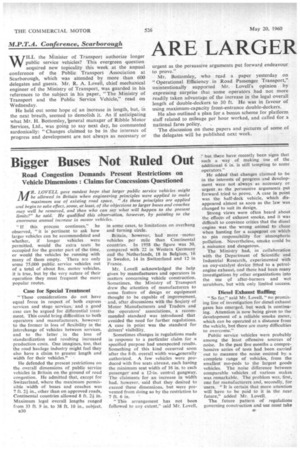Bigger Buses Not Ruled Out
Page 64

If you've noticed an error in this article please click here to report it so we can fix it.
Road Congestion Demands Present Restrictions on Vehicle Dimensions : Claims for Concessions Questioned
MR. LOVELL gave modest hope that larger public service vehicles might be allowed in Britain when engineering principles were applied to make maximum use of existing road space. "As these principles are applied and begin to take effect, some, at least, of the objections to larger buses and coaches may well be removed, and then who can say what will happen to the present limits?" he said. He qualified this observation, however, by pointing to the enormous annual increase in motor vehicles.
" If this process continues," he observed, "it is pertinent to ask how larger vehicles can be accommodated and whether, if longer vehicles were permitted. would the extra seats be occupied for the greater part of the time, or would the vehicles be running with many of them empty. There are only some 75,000 public service vehicles out of a total of about 8m. motor vehicles, it is true, but by the very nature of their operation they must frequent the more popular routes.
Case for Special Treatment
"These considerations do not have equal force in respect of both express services and stage services, and a good case can be argued for differential treatment. This could bring difficulties to both operators and manufacturers, however: to the former in loss of flexibility in the interchange of vehicles between services, and to the latter in the loss of standardization and resulting increased production costs. One imagines, too, that the road haulage industry might feel they also have a claim to greater length and width for their vehicles."
He defended the present restrictions on the overall dimensions of public service vehicles in Britain on the ground of road congestion. He admitted that, except for Switzerland, where the maximum permissible width of buses and coaches was 7 ft. 21 in., other than on approved roads, Continental countries allowed 8 ft. 21 in. Maximum legal overall lengths ranged from 33 ft. 9 in. to 38 ft. 10 in., subject.
B30 in some cases, to limitations on overhang and turning circle.
Britain, however, had more -motor vehicles per mile than Continental countries. In 1958 the figure was 30, compared with 22 in Western Germany and the Netherlands, 18 in Belgium, 16 in Sweden, 14 in Switzerland and 12 in Frante.
Mr. Lovell acknowledged the help given by manufacturers and operators in matters concerning vehicle construction. Sometimes, the Ministry of Transport drew the attention of manufacturers to some feature of design or equipment thought to be capable of improvement, and, after discussions with the Society of Motor Manufacturers and Traders and the operators' associations, a recommended standard was introduced that avoided the need for further regulations. A case in point was the standard for drivers' visibility.
Sometimes changes in regulations made in response to a particular claim for a specified purpose had unexpected results. Something of this kind occurred soon after the 8-ft. overall width was.generally authorized. A few vehicles were produced with five seats abreast, each having the minimum seat width of 16 in. to each passen,ger and a I2-in, central gangway. The claimants for an increase in width had, however, said that they desired to exceed these dimensions, but were prevented from doing so by the restriction to 7 ft. 6 in.
"This arrangement has not been followed to any extent," said Mr. Lovell, 1' but there have recently been signs that such a way of making use of the. additional 6 in. is still tempting to some operators."
He added that changes claimed to be in the interests of progress and development were not always as necessary or urgent as the persuasive arguments put forward tried to prove. A case in point was the half-deck vehicle, which disappeared almost as soon as the law was changed to suit its design.
Strong views were often heard about the effects of exhaust smoke, and it was difficult to convince critics that the diesel engine was the wrong animal to chase when hunting for a scapegoat on which to pin responsibility for atmospheric pollution. Nevertheless, smoke could be a nuisance and dangerous.,
The Ministry had, in collaboration with the Department of Scientific and Industrial Research, experimented with an oxy-catalyst device fitted to a petrolengine exhaust, and there had been many investigations by other organizations into the use qf after-burners and wet scrubbers, but with only limited success.
Diesel Exhaust Baffling " So far," said Mr. Lovell. "no promising line of investigation for diesel exhaust gases has emerged, but work is continuing. Attention is now being given to the development of a reliable smoke meter, which can be operated at a distance from the vehicle, but there are many difficulties to overcome."
Public service vehicles were probably among the least offensive sources of noise. In the past five months a comprehensive series of tests had been carried out to measure the noise emitted by a complete range of vehicles, from the smallest mo-peds to the largest goods vehicles. The noise difference between comparable vehicles of various makes was remarkable. The problem was, first, one for manufacturers and, secondly, for users. "It is certain that more attention will have to be paid to it in the near future," added Mr. Lovell.
The future pattern of regulations governing construction and use must take •




















































































































